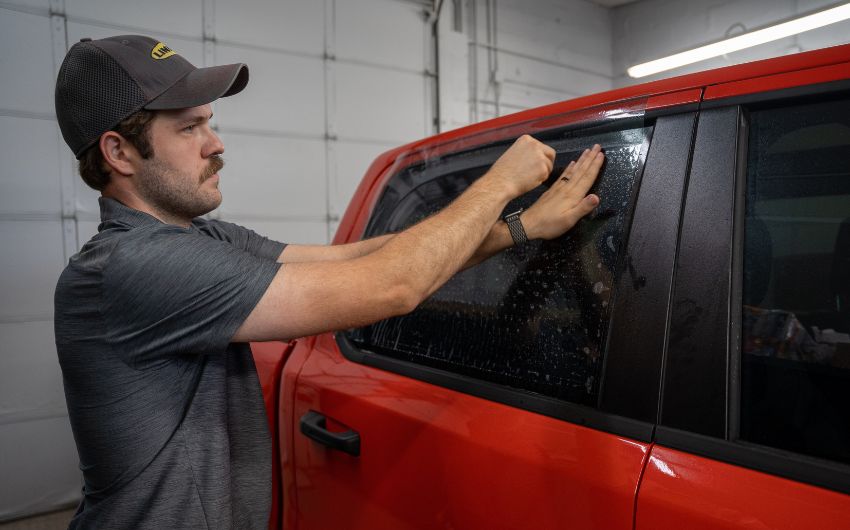Home Window Tinting Rules and Guidelines: What You Required to Know Before Tinting Your Cars And Truck
Before proceeding with home window tinting for your vehicle, it is necessary to familiarize yourself with the diverse regulations and guidelines that control this practice throughout various states. These laws dictate the permitted degrees of color darkness, usually determined by noticeable light transmission (VLT) percents, and include details terms for front windscreens focused on guaranteeing road safety and security. Additionally, particular territories might supply clinical exceptions for individuals with certifying problems. Comprehending these intricacies can conserve you from prospective lawful implications, yet what are the certain policies in your state?
Introduction of Home Window Tinting Laws
Window tinting laws are frequently subject to variation across different jurisdictions, showing local guidelines and safety and security factors to consider. These regulations dictate the allowable degrees of color darkness and reflectiveness on lorry windows, guaranteeing that chauffeurs preserve ample presence while likewise securing versus harmful UV rays and warmth.
Most policies classify home window tinting based on the Visible Light Transmission (VLT) percent, which suggests the amount of light that can pass through the home window. Normally, lower VLT portions signify darker colors. Legislations usually separate in between the front, side, and rear windows, with more stringent restrictions applied to the front windscreen to improve security for both the driver and various other road customers.
Furthermore, some territories enforce restrictions on the reflectivity of the tint, preventing too much glare that can impair exposure. Exemptions to these laws might exist for people with specific medical problems requiring extra sunlight defense. Compliance with home window tinting policies is important, as offenses can result in penalties, necessary elimination of the tint, and prospective rises in insurance policy premiums. For that reason, it is crucial for automobile proprietors to familiarize themselves with neighborhood legislations prior to continuing with window tinting installments.
State-by-State Tint Laws
Understanding the particular window tinting policies in each state is important for car owners seeking to follow the regulation. Each state in the united state has established its very own collection of guidelines regulating window tinting, which can vary considerably. These guidelines usually determine the allowed degrees of color darkness, the kinds of windows that can be tinted, and any kind of clinical exemptions that may use.
For circumstances, states like California have strict restrictions on color darkness for front windows, while others, such as New Mexico, may enable darker tints. In addition, particular states mandate particular visibility percentages for different home windows, consisting of the windscreen, front side home windows, and back home windows. It is crucial for cars and truck owners to acquaint themselves with their state's laws to stay clear of potential penalties or fines.
Additionally, some states may call for a certification sticker label to be put on tinted home windows, suggesting conformity with state laws. Failing to abide by these policies not just takes the chance of lawful effects however can also influence security and exposure while driving. Vehicle proprietors ought to carry out comprehensive research or get in touch with local authorities to ensure complete understanding and conformity with state-by-state color policies.
Allowed Tint Degrees and Kinds
Lots of automobile owners might be stunned to find out that permitted color levels and types differ widely across various states. Each state has actually developed its own guidelines concerning the permissible darkness and reflectivity of window color, frequently measured by Visible Light Transmission (VLT) percentages. VLT refers to the quantity of light that can go through the colored home windows; therefore, a lower portion suggests a darker color.

In addition, the kinds of color products enabled can differ, with some states banning mirror-like or metal coatings. It is essential for automobile proprietors to acquaint themselves with their state's certain laws to ensure compliance. Non-compliance can result in fines, compulsory elimination of the color, or various other legal effects, making it important to understand these laws prior to waging installment.
Medical Exemptions for Tinting
While not all states offer allowances for medical exceptions regarding home window tinting, those that do acknowledge the necessity for specific people to improve presence and comfort as a result of clinical problems. Various medical problems, such as lupus, skin cancer, and certain eye disorders, can provide people especially delicate to sunlight. Subsequently, these individuals might require darker colors to secure themselves from unsafe UV rays and glow.

It is very important to keep in mind that despite having a medical exception, there may still be limitations on the degree of color permitted. Compliance with state regulations ensures that people are both safeguarded and within legal restrictions. Those thinking about clinical exemptions ought to contact their local Division of Motor Autos or equal authority to comprehend the requirements and procedures needed to make an application for an exemption properly.
Penalties for Non-Compliance
Falling short to abide by home window tinting laws can lead to considerable penalties, which vary by state. Law enforcement companies are encouraged to issue citations for vehicles that do not stick to the specified tinting laws. These charges usually consist of fines, which can vary from small total up to several hundred dollars, relying on the extent of the violation and the state in inquiry.
In some territories, duplicated offenses may result in rising penalties or additional penalties, such as compulsory court looks. Non-compliance might necessitate the elimination of illegal tinting, frequently at the proprietor's expense. In extreme situations, habitual wrongdoers might face suspension of their car enrollment until compliance is attained.
Additionally, insurance policy implications may develop from getting multiple visit site citations for home window color violations. Insurance providers may check out such offenses as an indication of riskier habits, potentially leading to boosted premiums or problem in protection.
To stay clear of these penalties, it is crucial for vehicle owners to familiarize themselves with their neighborhood home window tinting regulations and guarantee that their car complies (Window Tinting). This positive method not only prevents lawful ramifications yet additionally promotes roadway safety
Conclusion

Many guidelines identify home window tinting based on the Visible Light Transmission (VLT) percentage, which shows the amount of light that can pass with the home window. Compliance with window tinting regulations is critical, as offenses can result in fines, compulsory removal of the tint, and possible rises in insurance policy premiums.Understanding the details home window tinting guidelines in each state is essential for lorry proprietors looking for to conform with the regulation. These guidelines often dictate the allowed degrees of color darkness, the kinds of windows that can be tinted, and any type of clinical exemptions that might use.
For circumstances, states like The golden state have stringent limitations on tint darkness for front home windows, while others, such as New Mexico, might allow darker colors.